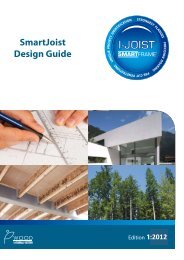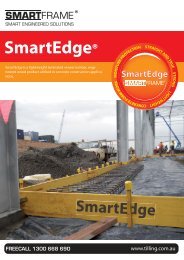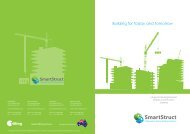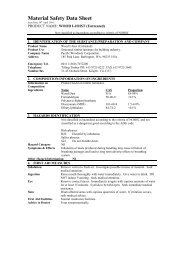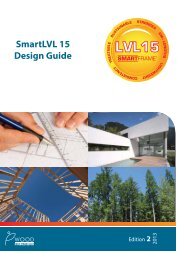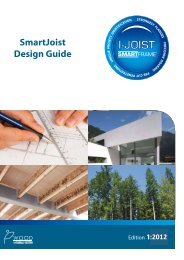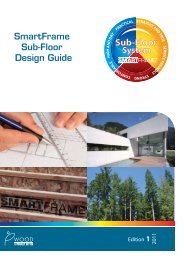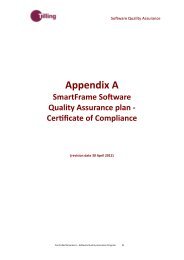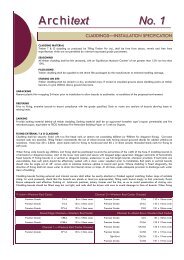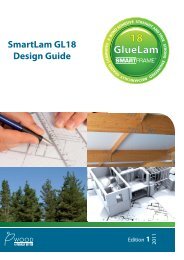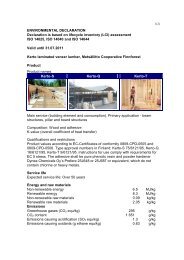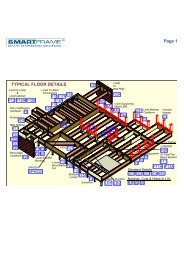SmartLam GL17C Brochure - Tilling Timber
SmartLam GL17C Brochure - Tilling Timber
SmartLam GL17C Brochure - Tilling Timber
Create successful ePaper yourself
Turn your PDF publications into a flip-book with our unique Google optimized e-Paper software.
PAINTING LOSP TREATED <strong>SmartLam</strong> BEAMS<br />
Wait until excess solvents have evaporated and timber is dry.<br />
The pressure of the solvent (white spirits) from the LOSP treatment<br />
may affect the drying and hardening of paints if there has<br />
been insufficient evaporation time after the treatment. It is<br />
strongly recommended that the treated timber is left to recondition<br />
for at least 7 days in the end use situation before painting.<br />
Resin bleeding can occasionally be a problem with LOSP treated<br />
softwoods. See “RESIN BLEEDS” below<br />
One coat of premium quality primer as a minimum should be<br />
applied to all surfaces prior to erection of beam and to any cuts<br />
or holes drilled. If the first coat of primer, sealant paint or stain<br />
fails to dry or adhere within the time expected, do not proceed<br />
to any further coats until the first coat has achieved satisfactory<br />
dryness and adhesion. If the first coat fails to dry it may be<br />
necessary to strip back to bare timber and allow it to weather<br />
for another week or two.<br />
1 Paint<br />
• Exterior solid colour acrylic finish. One coat of oil based<br />
primer followed by one or two coats of the exterior<br />
acrylic finish as required.<br />
• Exterior solid colour oil based enamel. One coat of oil<br />
based primer followed by one coat of oil based undercoat<br />
(if required) then two coats of the oil based enamel.<br />
2 Stains<br />
Exterior semi-transparent or solid colour penetrating oil based<br />
stain or similar. Two or three coats of the stain as required or<br />
recommended by the manufacturer.<br />
Water based stains and un-pigmented sealants, oil or water<br />
repellents are NOT recommended.<br />
RESIN BLEED<br />
Resin Bleed may be identified by a sticky, clear or white exudation<br />
that has a characteristic aromatic odour. It is most commonly<br />
encountered around knots or other imperfections in the<br />
wood and in places where the tree sustained damage. Paint or<br />
stain will generally be softened and may even be lifted off by a<br />
resin bleed.<br />
If resin bleed occurs the following steps are recommended:<br />
i. Physically remove the exuded resin from the<br />
surface<br />
ii. Allow to weather for a few days to ensure the<br />
bleed has ceased.<br />
iii. Seal the affected area with a suitable sealant<br />
such as Resene Everseal.<br />
Further advice mat be obtained from AS 2311<br />
FIRE RATINGS (RESISTANCE)<br />
In a fire, <strong>SmartLam</strong> GL17 beams have an inherent fire rating.<br />
As timber burns, a layer of charcoal forms enclosing a core of<br />
timber which is yet unaffected by the fire. This timber core<br />
maintains its structural capacity. Hence, dependant upon the<br />
loss of material to the charcoal layer, the <strong>SmartLam</strong> GL17<br />
beam can carry the dead load of the structure for a period of<br />
time.<br />
Resistance to fire can be established by reference to AS<br />
1720.4 Fire Resistance of Structural <strong>Timber</strong> Members, using a<br />
charring rate of 0.66 mm per minute. Therefore, the strength<br />
and stiffness after fire may be assessed using the uncharred<br />
residual cross section computed for the period of exposure to<br />
the fire.<br />
CHECKING IN <strong>SmartLam</strong> GLULAM<br />
One of the advantages of glued laminated timber construction<br />
is that while seasoning checks may occur for the same reasons<br />
that they do in sawn members, checking in glued laminated<br />
timber will generally occur to a much lesser degree because<br />
of careful control of the moisture content of timber used<br />
for laminating. Checks in wood are separations along the fibres<br />
normally occurring across the rings of annual growth resulting<br />
from stresses developed during changes in moisture content.<br />
Checks in glued laminate timber may appear as openings parallel<br />
to the grain on the sides of members.<br />
As wood loses moisture to the surrounding atmosphere, the<br />
outer fibres of the member lose moisture at a more rapid rate<br />
than do the inner fibres. As outer fibres try to shrink, they are<br />
restrained by the inner portion of the member that has higher<br />
moisture content. The more rapid the rate of drying, the greater<br />
will be the differential in shrinkage between the outer and<br />
inner fibres resulting in higher shrinkage stresses.<br />
These resultant stresses perpendicular to the grain of the<br />
wood can cause characteristic wood seasoning checks. The<br />
influence of checks on the structural performance of glued<br />
laminated timber members is generally minor. Checking can be<br />
minimized by careful installation practices that avoid prolonged<br />
exposure of the members during construction.<br />
IDENTIFICATION OF CHECKING<br />
Checks occur as transverse separations or openings that are<br />
nearly parallel to the grain direction in glued laminated timber<br />
and generally follow the grain direction around knots and along<br />
sloping grain. Differences in the shrinkage rate of individual<br />
laminations used is glued laminated timber tend to concentrate<br />
shrinkage stresses at or near glue lines, resulting in checks.<br />
Checks are often confused with delamination that occurs when<br />
the glue bond is not adequate. The presence of wood fibre<br />
separation in these openings is the key distinguishing characteristic<br />
of seasoning checks. Openings due to inadequate adhesive<br />
bonding may appear as smooth wood surface separations,<br />
possibly darkened by the adhesive film, or as glossy surface<br />
areas of adhesive with an absence of torn wood fibres.<br />
<strong>SmartLam</strong> GL17 Design Guide 9



